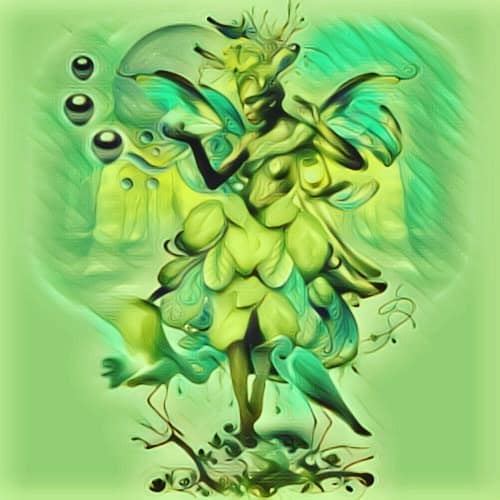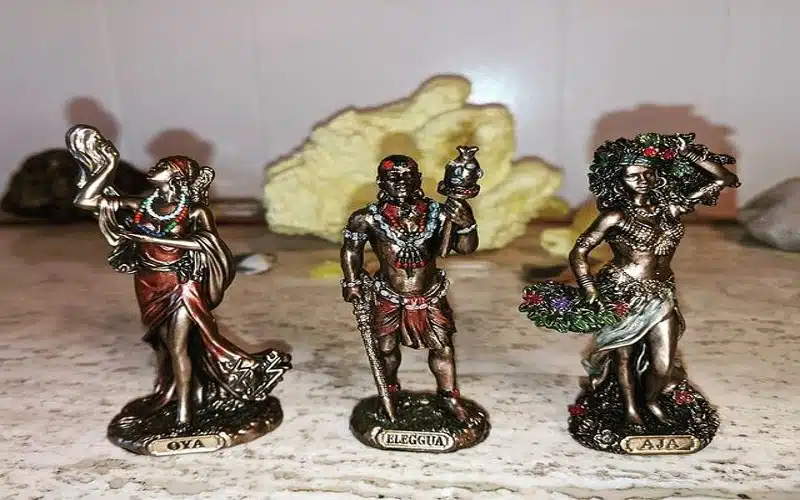Orisha Aja is the orisha of forest, she is the master of healing and herbs. This goddess is a patron of the forest and all the animals within it. This orisha holds the secrets of botany. She passed this skill to us Yoruba people, and we practice her craft to this very day.
She is one of the rarest African goddesses and not much is known about her because she reveals herself to humans and not to harm or scare them. This orisha also goes by the name “wild wind”.
Etymology of Orisha Aja
How to pronounce Aja
A sounds like Ah (exclamation), and you pronounce Ja as in Jam. There you have it, Ah-Jaa
Meaning of Orisha Aja
Aja simply means wind or wild wind.
Titles of Orisha Aja
- Orisha of forest and herbs.
- Soul of the forest.
- Master of healing.
- goddess of animals.
- Wild wind.
Mythology of Orisha Aja

One of the popular myths of this orisha, the goddess of forest and herbs, is that whenever her wind takes away someone, on their return, they become a powerful Babalawo (herbalist). The journey supposedly will have a duration of between 7 days to 3 months, and they think person is in the land of the dead or heaven.
Orisha Aje and Orisha Aja
These two orishas Aje (goddess of wealth) and Aja, are often confused because of the similarity in their spellings.
Orisha Ajé is a powerful deity in Yoruba mythology. She brings good fortune, wealth and prosperity to those who worship and honor her. She is the symbol of prosperity and abundance, and her worship is linked to the pursuit of wealth and material success.
While Orisha Aja is also a significant goddess in Yoruba mythology. She is the orisha of the forest and herbs and she is the master of healing. She is the orisha we will be discussing.
Powers of Orisha Aja

Despite this goddess not being one of the most prominent in her pantheon she has a lot to offer to we humans.
- This goddess possesses the power to protect the forest.
- She uses plants and herbs for healing and cures the sick. In her forests she would find plants with medicinal properties and mix the herbs and roots and other plant parts together to form the cure that was needed. One fancy thing about her is that she wasn’t too tight-lipped with her knowledge either and everyone knew her for sharing the information she gained with humans.
- She is a botanist, she knows all about plants.
- Usually the only interactions that occur between nature gods and humans is either to scare humans out of the woods or to kill them. But this goddess isn’t like that. Instead of trying to keep people out of the forests and away from nature, she extended her realm to us in order to show the importance of what was in the natural world.
- She is the protector and healer of all animals.
- One other fancy thing she also does is that, she only appears to those that seek her and she sometimes takes them on a journey for some time, and when the person arrives, they return as a powerful healer.
She wasn’t too tight-lipped with her knowledge and was well-known for sharing the information she gained with humans.
Colors/ Symbols associated with Aja Orisha
Symbols
Some symbols related to this goddess includes Leaves, medicinal plants and roots, water, wind, trees.
Colors
- Green.
- Brown.
- Yellow.
- White.
Worship of Orisha Aja
This goddess is not one of the orishas that needs to be celebrated, she is only called upon for healing and for her wisdom.
Orisha Aja across borders
West Africa
In countries like Nigeria, Benin and Togo, they know Orisha Aja as the African goddess of healing.
Note
Today, many Yoruba and African Orishas can be found in the Caribbean and Santeria with only small alterations, if any, to their original characters from Nigeria.
In the case of this goddess, it doesn’t seem that she managed to make it to the Caribbean and santeria. As unfortunate as this is, it does make sense. She wasn’t one of the central or highest ranking gods in her pantheon, and she wouldn’t be someone to pray to get assistance. However, that doesn’t mean that she isn’t important to us humans.
Other goddesses

In addition to the Orisha mentioned earlier, there are many others that are also worth learning about, such as Yemoja, the mother goddess of the ocean, Osun, the goddess of fertility and love, Ayelala, the Orisha of vengeance and Aje, the goddess of wealth.
The Orishas are a fascinating aspect of Yoruba culture and mythology, and there is so much to learn and discover. Happy reading!
Final Thoughts
- Orisha Aja is a powerful and intriguing deity in Yoruba mythology, people know her for her association with the forest, healing, and animals.
- She is a rare goddess, who reveals herself to humans only when she is seeked, and not really popular outside of West Africa.
Despite this, her powers and attributes make her an important figure in Yoruba spirituality, and her connection to nature and healing is a reminder of the importance of respecting and preserving the natural world.
- The myths surrounding this goddess, such as her ability to heal and protect animals, and her journey with those who seek her, highlight her role as a guardian and teacher. Her association with leaves, medicinal plants, roots, water, wind, and trees further emphasizes her connection to the natural world.
- It is interesting to note that while this goddess is not one of the most prominent deities in Yoruba mythology, she still has a lot to offer to humans. Her willingness to share her knowledge and healing powers with those who seek her out is a testament to her benevolent nature.
- The colors and symbols associated with this African goddess include green, brown, yellow, and white, are also significant, as they represent the natural world and the elements she is associated with.
Frequently Asked Questions
She is an Orisha, the spirit of the forest, the animals within it and herbal healers. In her forests she would find plants with medicinal properties and mix the herbs and roots and other plant parts together to find cures for the sick. She shared much of her knowledge with humans waiting for someone to come and find her to share it.
The word Aja itself is a Yoruba word which means wild wind.
Aya, who they also call Aja is the Mesopotamian goddess of dawn.
Don’t mistake her with the goddess we did discuss, Aja is the Yoruba goddess of healing and their only similarity is in the spelling of their names.
– This goddess possess the power to protect the forests.
– She uses plants and herbs for healing and to cure the sick.
– One of her important roles is that she is the protector of all animals.
Her symbols include wind, leaves, herbs, trees and medicinal plants.
Green, brown, yellow, white.
A sounds like Ah (exclamation)
Pronounce Ja as in Jam.
There you have it, Ah-Jaa
Orisha Aja.
Featured Image Credit: bubblegum_scorpion on Instagram
